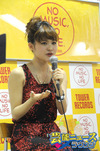http://the-japan-news.com/news/article/0001860712
LOOKING EAST / The creative secrets of an anison artist

- inShare

Chiaki Ishikawa
6:34 am, January 28, 2015
By Takamasa Sakurai / Special to The Japan NewsI saw something impressive at Japan Expo Sud in Marseille, France, in October 2010.
I happened to find the word “karaoke” on a program of a hall there. Curious, I entered the hall, where I saw about 1,000 young French people singing anime theme songs together in Japanese as videos of the anime’s openings appeared one after another on a screen.
These people looked as if they were having a wonderful time singing songs for such popular anime as “Hagane no Renkinjutsushi” (Fullmetal Alchemist) and “Suzumiya Haruhi no Yuutsu” (The Melancholy of Haruhi Suzumiya). A few of my friends and I were probably the only Japanese there. I sincerely wished I could broadcast the event live in Japan.
In the 20th century, Japanese anime were broadcast in France after changing their titles and theme songs in French ways. For example, “City Hunter,” which is still popular in France, was aired under the title “Nicky Larson.”
Times have changed. Today, anime theme songs are aired in the original Japanese. Fans overseas use the word “anison,” a Japanese word meaning “anime song.”
Anison are very important for anime works, as each anime’s world is reflected in the songs.
Each song also has to be an individual finished piece of entertainment in its own right.
So how do artists working in the anison world create songs that can measure up to such tough requirements?
“People often say to me, ‘Your songs are very suited to anime stories.’ But I don’t try to suit my songs to stories, actually. I can’t write them unless I take the viewpoint of a character in an anime or game,” said my friend Chiaki Ishikawa, a singer-songwriter and creator of anime and game theme songs.
“In other words, I become an anime character in my mind to create my song from the character’s perspective. I’ve worked this way on all my anime songs, such as ‘Mobile Suit Gundam [Seed]’ and ‘Sengoku Basara.’”
She also said that when working on “Sengoku Basara,” she imagined visiting the Sekigahara battlefield and wondered if such killing was excusable.
“I think at this point [the song] becomes suited to its story pretty well,” she said. “However, it’s like I have another self who’s viewing the battle on Earth as if from space. I make anime songs by taking both a close look and a far-off look at the story. The author of an ongoing series manga once said to me, ‘Your song seems to have predicted the ending of my work.’”
Ishikawa has many enthusiastic fans. Some of them enjoy anime together with her songs, while others just like to listen to her songs.
“Even if the story is set in the Warring States Period or some other unusual situation, listeners probably find something universal in their daily life connected to my songs. It may be loneliness, or something sentimental,” she said.
Many young people worldwide project themselves onto anime characters. People have many different facets to their personalities, so I can well understand their attraction to Japanese anime characters who can’t be explained simply in terms of good and evil.
“I think Japanese anime depicts many delicate shades of emotion,” Ishikawa said. “Somebody is happy now, but who knows about tomorrow — depicting incompleteness may be one of its characteristics.”
Her songs are often used for crucial episodes in the middle of an anime, such as ones depicting the death of an important character.
“Recently, I’ve also been asked to create an ending piece for just the seventh or 10th episode of an anime, for example. That’s where the essence of the story is revealed,” she said. “These pieces need to be even better, so I felt a bit reluctant to create them at first. But each time, I’ve tried to make that particular episode unforgettable. So I may have become good at creating music that way.”
Anime is a form of entertainment in which viewers put 30 minutes, or two hours, of their lives into the hands of its creators.
“We need to understand how viewers want to see each anime,” she said. “When I think about what aftertaste I want to add, I come up with ‘tears,’ for example, as an important keyword. This is part of the technique required for creating anime music. We need to understand their stories’ distinctive ebb and flow. Otherwise, we can’t create anime songs.”
Anime is the manifestation of good harmony among the ideas and accumulated techniques of its creators, as I learned anew from Ishikawa’s work.
(The next installment will appear Feb. 14.)
Sakurai is a content producer who uses events and seminars to engage in “pop culture diplomacy.” Follow him at
http://twitter.com/sakuraitakamasa







 I just don't like Kimi ga Ita Monogatari in this album...the drum is really messy. The single version is pure love.
I just don't like Kimi ga Ita Monogatari in this album...the drum is really messy. The single version is pure love.